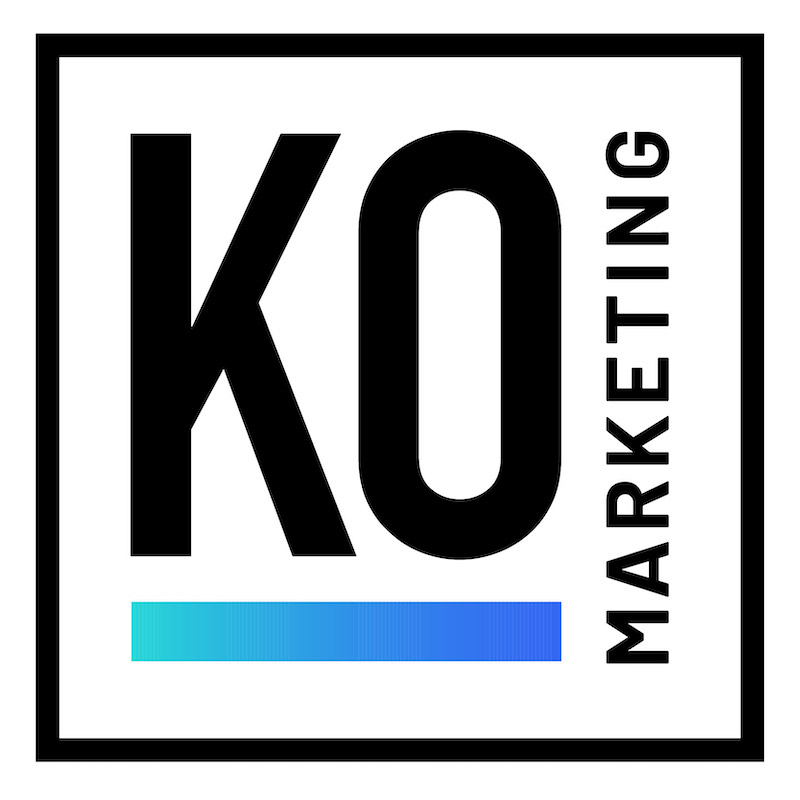What is the first thing that comes to mind when thinking about what makes a brand? Chances are that your first thought is visual elements: logos, packaging, visual displays and advertisements. The brand voice is often overlooked. In an age where both companies and consumers alike dominate digital chatter, defining and refining your voice to stand out among the crowd has never been more vital.
Whether you’re building a new brand from scratch or spearheading a rebranding journey, it’s important to have a strong sense of identity. Who are you? More importantly, how do you communicate this identity to your prospects and customers? The way you speak to your audience defines their first impression of you and whether they want to develop a personal connection or disregard your messages entirely.
Understanding what a brand voice is, its importance, and how to develop and use it for your own brand is vital for your digital marketing presence.
What is a Brand Voice?
Even if you are unfamiliar with the term “brand voice”, you’ve absolutely experienced it out in the world.
Imagine for a moment that you received a phone call from a good friend. They called from a new number and caller ID didn’t immediately identify them; how do you recognize the voice and who it belongs to? Your friend more than likely speaks in similar patterns. The way he tells stories is consistent; from the phrases he uses to the tone, inflection, and even the content of the information he shares (or decides not to share), there’s distinct and recognizable characteristics that define this voice as your friend.
As another example, think about the last time you were introduced to a stranger. In only a brief conversation, you probably started to deduce who they are as a person. Maybe their voice was hesitant and they often ended sentences in requests for affirmation such as “…right?”, “…don’t you think?”, or “…but I could be wrong.” You probably figured out rather quickly that they were shy or lacked confidence. The way a person talks gives insight into their values, personality, and character.
In the same way that a person’s voice defines their character, brand voice is much the same. Brand voice is defined simply as the written or verbal expression of your brand personality in all communications.
Brand voice is a critical factor in your marketing strategy. Consistency across different channels, regardless of who creates the content, is impossible without defining your voice. You may have different teams or individuals who develop the content for email communications, social media, and blog posts. By uniting them all under a common voice, your audience is better able to connect with and understand your brand.
Brand Voices in Action
Taking a look at brand voices in action can help understand not only what a voice is, but how it helps elevate their marketing strategies.
Apple is a great example of a strong, consistent brand voice. Take a look at the heading on the landing page for the iPhone 13 at the time of its launch:
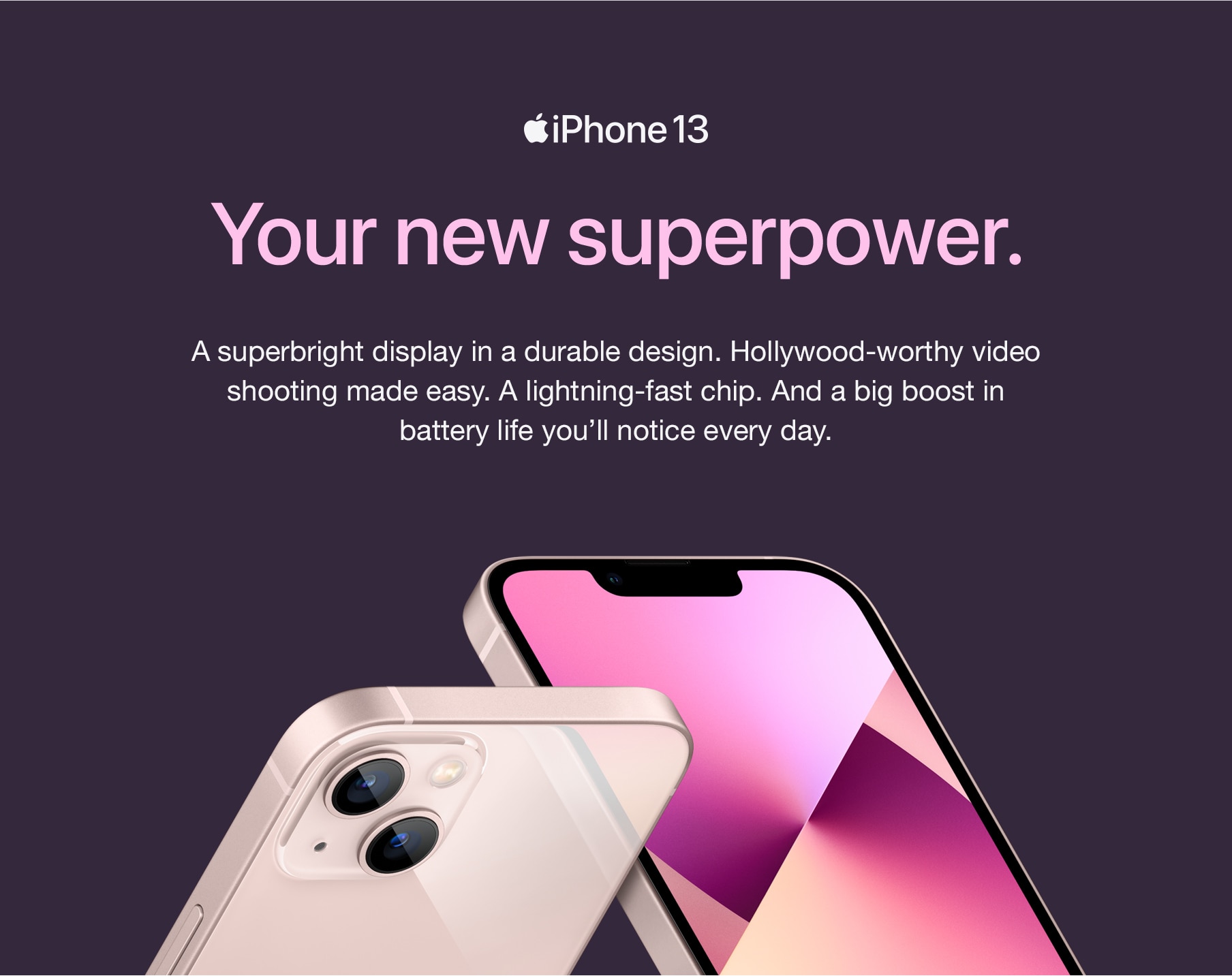
- Accessibility & Inclusion: The brand uses words that are easy for any reader to comprehend; universal comparisons like “Hollywood” don’t require any tech background to understand. The simplicity of their message gives the impression of accessibility and breaking down the barriers to entry. With their careful word choice, Apple shows their audience that their products are simple and usable by anyone.
- Quality & Superiority: A sense of smugness can easily backfire, but Apple has mastered the fine balance of a slight air of superiority without becoming unlikable. An informal, almost cheeky addition like “…you’ll notice every day” in the example above punctuates a somewhat dry listing of qualities with a promise to the customer: You will like this product for its superior quality.
Not only does this tone appear on Apple’s website, but consistently across multiple platforms as well. Take a look at this Twitter ad:
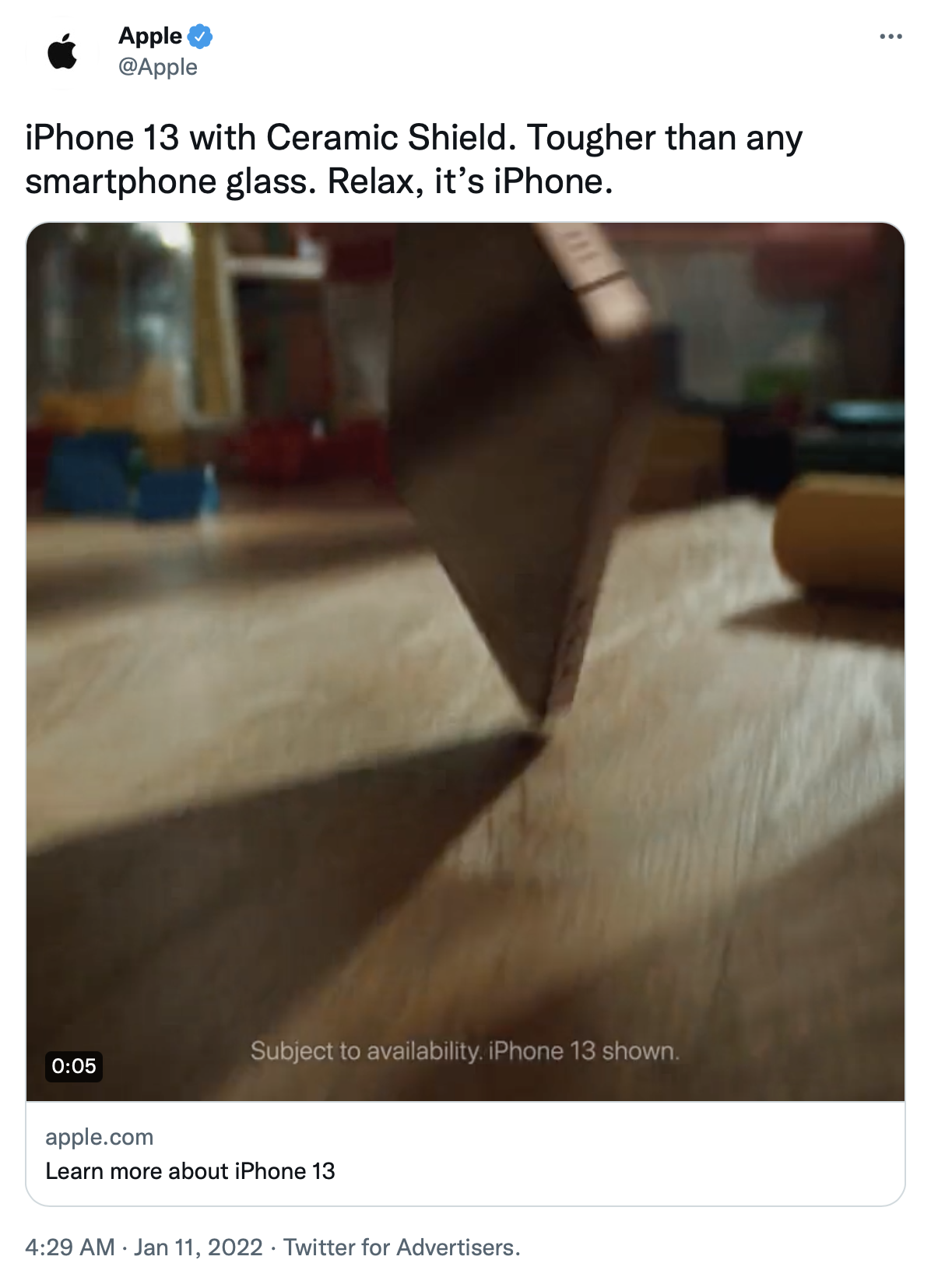
Spotify, one of Apple’s competitors for music streaming platforms, approaches their brand voice very differently. Take a look at the examples below:


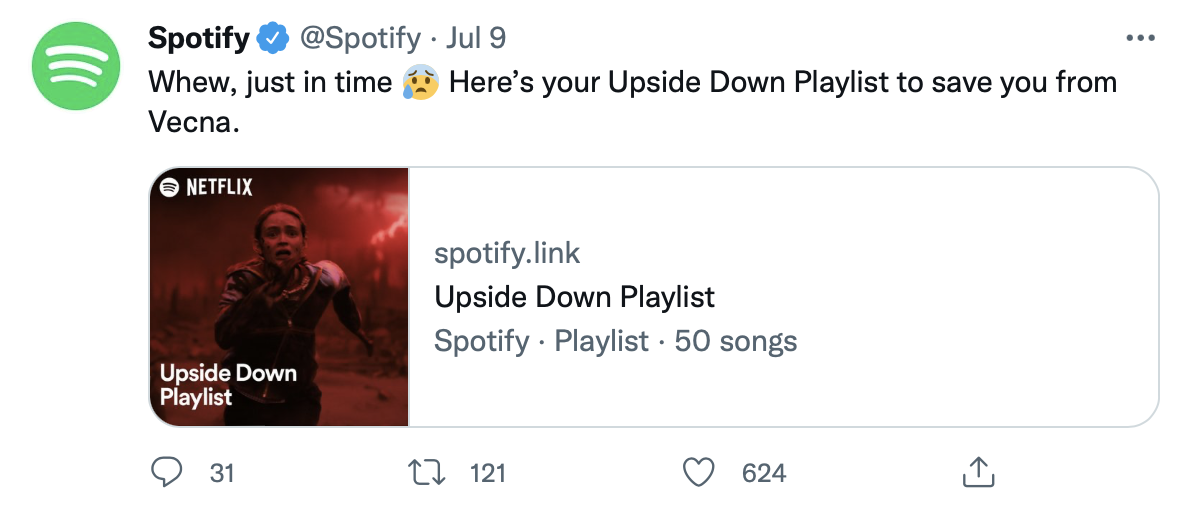
In two points, Spotify’s brand voice can be summed up with the following:
- Casual & Friendly: The content of Spotify’s posts is conversational, either starting a discussion or joining in on ongoing trends with their own contributions. Using emojis is a quick and easy way to project a more casual image. In one of the above examples, Spotify takes initiative by starting the conversation, asking people what they’re listening to. They speak like a friend would and also create a game out of the experience by challenging their followers to give them the funniest or best responses.
- Young & Trendy: The phrases that Spotify uses are the same that teens and young adults use conversationally, projecting an image of being just as cool and in touch as the kids are. The phrasing of “Thursdays are for crying…” is mirroring the social posts of their audience. Taking it a step further, Spotify also follows social trends and pop culture, such as with their Stranger Things Upside Down playlist.
The examples above were more than likely created by different people on their social media team but still project the image of a unified voice, as if it’s one human person speaking to their followers. Their voice isn’t limited to their social media presence either, though it may differ slightly based on the context. Take the excerpt from the article written and released by Spotify below:
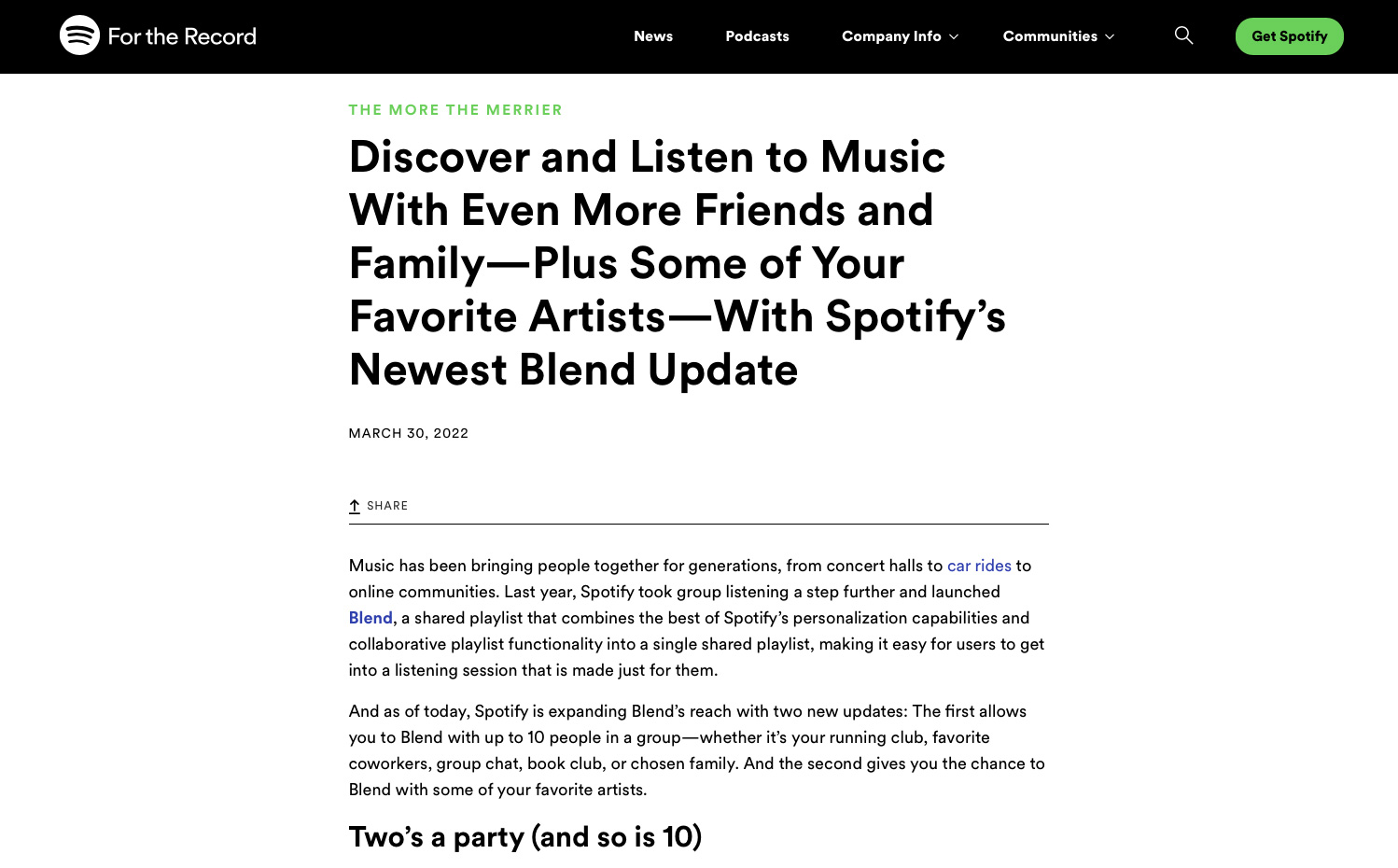
The way that you talk to your friends differs from the way you’d present yourself during a job interview, but that doesn’t mean that you lose your entire personality. In the excerpt from Spotify’s blog, their sense of humor and conversational tone is still fully intact despite taking on a more professional tone as they announce the updates to their service. Even the name of their blog, For the Record, is a pun that amuses and delights readers.
Why Does Your Brand Voice Matter?
Your brand voice is a vital component of your overall brand image. The digital landscape is crowded not just with potential customers, but also with your competition. While a unique visual brand helps, it can only take you so far in differentiating your brand from all of the other noise vying for your audience’s attention.
The most important reasons for developing your brand voice can be summed up in two points:
- Stand out from your competition. Those who have a weak brand image have a harder time standing out from their competitors. Having a strong brand voice not only strengthens your overall image but also makes people want to interact with your brand more. Not only should your brand voice be clear and consistent, but it should also differentiate you from other brands in a positive, beneficial way.
- Connect with your audience. It’s a common mistake; some brands have such generic, corporate voices that they forget the social part of social media. No one wants to interact with a faceless corporation; humans have the innate urge to connect with other humans. Though your brand is not a single person, creating a sort of persona with a human-like voice fosters an emotional bond with your audience. That’s not to say that your voice can’t be professional; while you might have a wise-cracking Twitter presence, your instructional videos can retain that sense of humor in a more helpful and friendly manner.
Any content you create should be consistent and cohesive. As Marty Neumeier of the Brand Gap has said, “If you can’t tell who’s talking when the trademark is covered, then the brand’s voice is not distinctive.”
How to Develop Your Brands Voice
1. Get Started with Your Team
The first step in starting a project is having a plan. Developing your brand voice may seem like an intimidating experience, but it’s much easier than you might think. It’s not a chore or even a hunt; your brand voice already exists, it’s just a matter of identifying it.
While some brands may have a long, drawn out process for developing their voice, it’s best to gather only the most relevant people and try to have some fun with the process. Trying to hammer everything down in one chaotic brainstorming session and too many different opinions is a recipe for disaster, so consider the following options:
- If you want the opinions of a larger group, poll them in advance to get their thoughts to present at the smaller group brainstorming session.
- Who needs to be present for the brainstorming session? Your branding team, founder, and key stakeholders may all need to be present. Keep in mind that everyone will have strong opinions and a smaller group may be more beneficial for making progress.
- Designate a point person to lead the conversation and help come to compromises and agreements that everyone is happy with. Someone should also be collecting feedback from this meeting.
When meeting with the team, it’s important to not just listen to the words they’re speaking, but also how they’re saying them. Is it joking or serious? Lighthearted or to the point? These details may also help define your brand voice.
2. Understand Your Identity
When developing your brand voice, you want to define who your brand actually is and what your values and mission are. You may already have an idea of this, but talking with employees, stakeholders, and even customers may help shed some clarity on what your image currently is. When listening to responses, try not to take their words at face value and dig deeper by looking for common themes that appear between the different groups.
These questions will help you nail down your brand image:
- When people interact with your brand, what do you want them to feel? Define the big-picture experience you’d like to create.
- What words would you use to describe your brand? If you ask a large group this, try to determine common threads or connections between different descriptors.
- What does the competition sound like? How can you differentiate your brand from them? Is there a certain trend that you may want to stay away from?
- What is another brand with a voice you love? It doesn’t have to be another brand in your industry, but consider how and why this voice resonated with you.
- If your brand was a celebrity, who would it be? It doesn’t necessarily need to be a single person or someone who actually exists; for example, a health and fitness brand might describe themselves as Chris Hemsworth’s even bigger brother.
- How do you want to talk about yourselves? What type of language do you currently use to describe your brand?
- What do you not want to be or want to avoid? Examples of brand voices you dislike or knowing what you want to avoid will also help define your voice.
If you already have a mission or value statement, starting from there can also help nail down the key characteristics of your brand.
3. Reference Buyer Personas
Whether or not you’ve created a successful brand voice will be determined by your audience, so it’s important to keep them in mind during the development and refinement processes. If your voice fails to connect with your audience, then it’s not the right voice for your brand.
Consider your buyer persona. Beyond basic demographics such as age, gender, and location, what does this person like? Would they prefer to read journalistic articles written in a formal, authoritative tone or skim through funny posts on social media? Do they have a sense of humor and like to laugh or prefer that everyone just tells it straight?
Conducting research to discover what other content your audience consumes will help you better understand how to create content that they will want to interact with. Remember that your view of your audience may differ from what it is in reality; while the “average” buyer at Home Depot is a middle-aged suburban man, a whopping 45% of their buyers are women who are initiating home improvement projects of their own. It’s important to consider that your assumptions may cause bias that unintentionally misunderstands your audience.
Using tools such as Google Analytics can help you determine if there’s any pattern among the viewers of your website and the other websites they frequent. Learning what other content they consume will help you develop an appealing voice. If your audience prefers to get news from Buzzfeed instead of the Democrat & Chronicle, they likely prefer a more casual, humorous voice opposed to academic-style content.
4. Analyze Top-Performing Pieces
If you’ve been posting content for at least the last few months, then taking a closer look at the posts that performed the best may have some important insights. What did you do differently in those posts? Break each top post down to the characteristics that would best describe each one and identify any common threads or similarities.
You might notice that your best posts include pop culture references, or maybe they use especially flowery poetic language. Maybe you did a deep dive and published original research to support your hypothesis and your audience responded well to it.
The pieces that performed best are the ones that are already resonating with your audience. Usually, this can be credited to the voice. The aspects of the voice of these top-performing posts should be replicated across the brand as much as possible.
5. Create a Reference Document
Once you’ve developed a plan for your brand voice, you’ll want to create a document for anyone in the company to reference for any communications. This voice should apply to multiple departments, from how support representatives speak with customers to marketing writing copy for a blog or press release. A clear guide on how to put the voice to practice is an absolute must.
This document should translate the ideas of the voice into tangible action and examples. How do your copywriters take the concept of a “approachable yet empowering and unconventional voice” and translate it into written content? Giving them examples of the voice in action or “do” and “don’t” rules will help guide everyone in understanding how to apply the voice.
A template for everyone to follow may look something like the following:
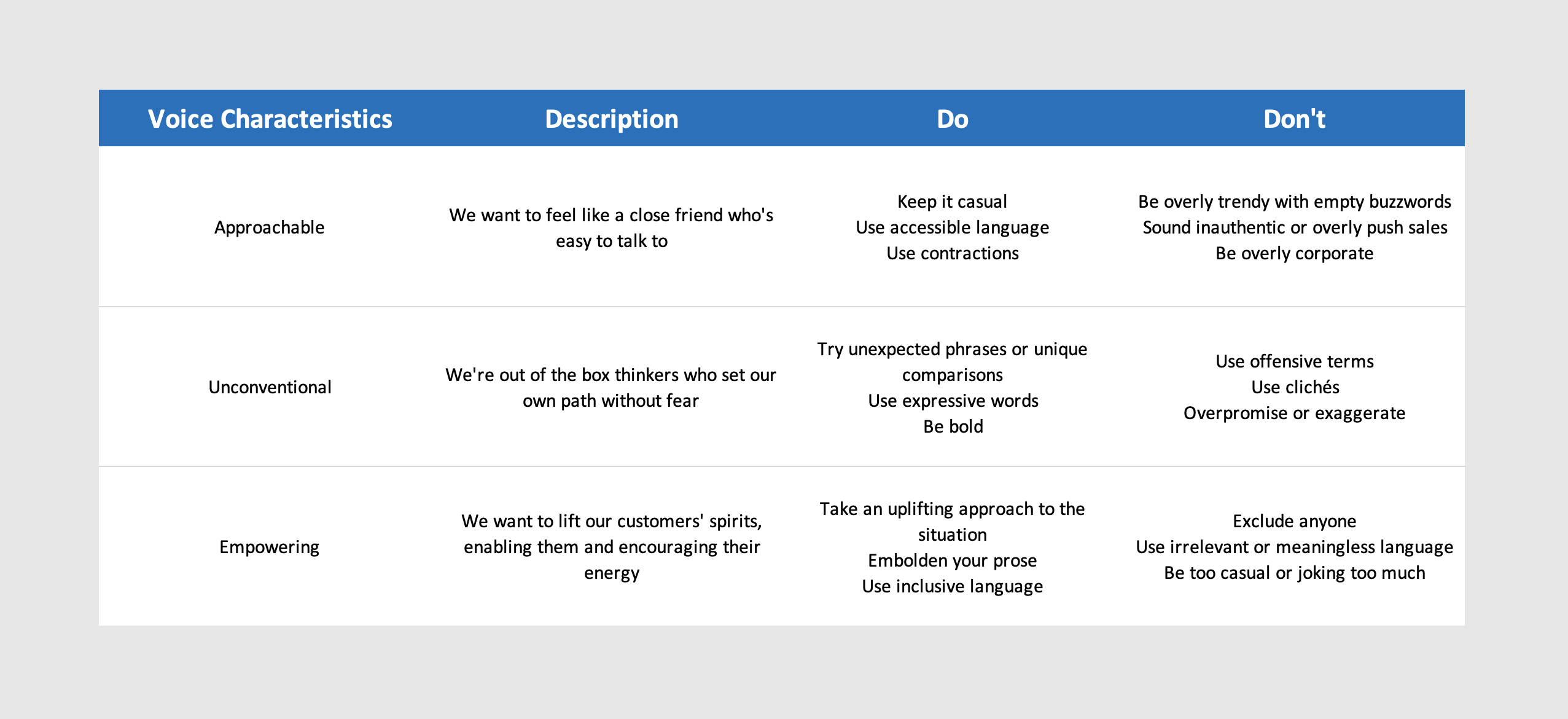
A good brand starts with good content. Good content always starts with your voice. By arming yourself with more information about brand voice, you’re well on your way to creating your own. No personality is too much or too big as long as it suits your brand and audience. In fact, a voice with a big personality might be exactly what you need.
